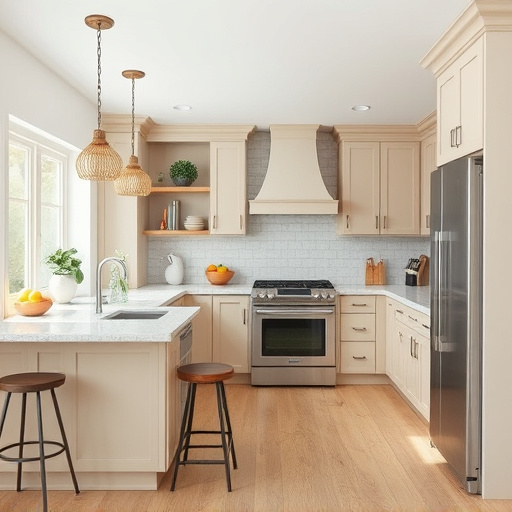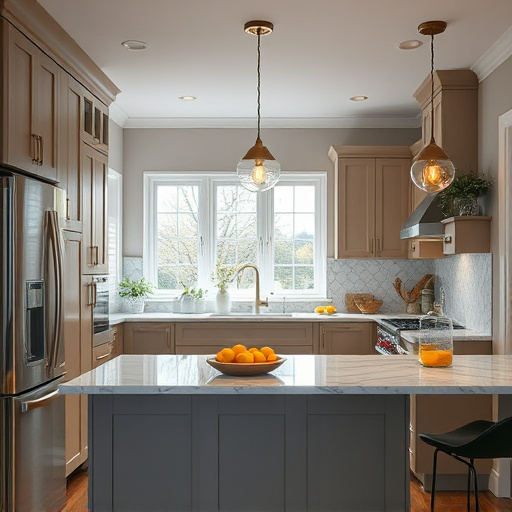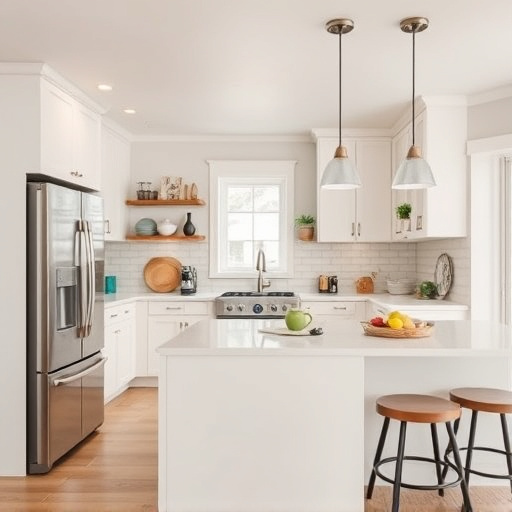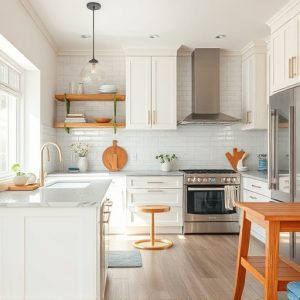When planning kitchen renovations, understanding plumbing requirements for new appliances and fixtures is crucial. Anticipate water pressure, flow rates, and drainage needs to prevent costly mid-project changes. Map existing pipes, check supply lines and drainage systems, and consider appliance placement to ensure sufficient space. Prioritize updates for optimal performance from high-end and water-efficient fixtures. Integrate smart home technology by upgrading plumbing infrastructure to support specialized appliances and control systems. Focus on ventilation and drainage improvements for updated aesthetics and functionality. Select trustworthy plumbers specializing in kitchen renovations for reliable service and optimal results.
Staying ahead of the curve in kitchen renovations involves understanding the evolving needs of modern appliances and fixtures. As technology advances, so do energy-efficient requirements and smart home integrations. This article guides you through essential plumbing updates needed to support these upgrades, from assessing your kitchen’s layout to choosing reliable plumbers. We explore key areas like proper ventilation, drainage, and integrating smart technology for a seamless, efficient renovation experience.
- Understanding New Appliance and Fixture Requirements
- Assessing Your Kitchen's Plumbing Layout
- Essential Upgrades for Modern Fixtures
- Integrating Smart Home Technology
- Ensuring Proper Ventilation and Drainage
- Choosing Reliable Plumbers for Kitchen Renovations
Understanding New Appliance and Fixture Requirements

When embarking on kitchen renovations, understanding the specific requirements of new appliances and fixtures is paramount. Each modern appliance, from sleek dishwashers to energy-efficient refrigerators, comes with unique plumbing needs. These can range from altered water supply lines to enhanced drainage systems. As such, it’s crucial to assess how these new additions will interact with your existing plumbing infrastructure.
For instance, high-end appliances often demand increased water pressure and flow rates, necessitating updates to your plumbing lines. Similarly, certain fixtures, like low-flow faucets or water-efficient toilets, require specific plumbing modifications to ensure optimal performance without compromising efficiency. By anticipating these requirements early in the renovation process, you can avoid costly mid-project changes and ensure a seamless integration of your new appliances and fixtures into your kitchen.
Assessing Your Kitchen's Plumbing Layout

Before diving into kitchen renovations, understanding your plumbing layout is crucial. Start by mapping out the existing pipes and fixtures to identify any potential challenges or limitations. Check for adequate water supply lines and drainage systems capable of supporting new appliances and fixtures. In many cases, updates may involve rerouting pipes or installing additional components to ensure smooth operation and prevent future clogs or leaks.
During this assessment, consider the placement of your sink, dishwasher, and other key elements. Ensure there’s sufficient space for new installations and that existing plumbing can accommodate additional demands without overstraining the system. This step is vital in kitchen renovations, as it helps avoid costly retrofits later and ensures a functional, modern space.
Essential Upgrades for Modern Fixtures

When undertaking kitchen renovations, prioritizing the right plumbing updates is key to ensuring your new fixtures and appliances function optimally. Modern kitchens often feature high-end appliances with advanced technology that require adequate water pressure and flow rates to perform at their best. Upgrading to a high-pressure pump can boost water delivery to these fixtures, providing the necessary force for efficient cleaning and improved performance. Additionally, installing smart valve systems allows for precise control over water temperature and pressure, offering both comfort and energy savings.
These upgrades are particularly essential if you’re incorporating water-efficient appliances or fixtures, as they can help maintain consistent water performance while reducing overall water consumption. By investing in these plumbing advancements, homeowners can future-proof their kitchens, ensuring they remain functional, efficient, and enjoyable spaces for years to come.
Integrating Smart Home Technology

As you plan kitchen renovations, integrating smart home technology can significantly enhance your plumbing system and overall experience. Smart appliances, such as refrigerators with touchscreens and voice-controlled dishwashers, require updated plumbing to accommodate their advanced features. These devices often demand additional water supply lines and specialized waste disposal systems for efficient operation. For instance, a smart coffee maker might need a dedicated water line for fresh, cold water at the push of a button.
Plumbing updates for smart home technology go beyond individual appliances. You may also want to install a centralized control system that allows you to manage all your kitchen appliances remotely. This involves upgrading your plumbing infrastructure to support data transmission and power lines necessary for these connected devices. Kitchen renovations that incorporate smart home technology not only add convenience but also contribute to a more efficient, modern living space.
Ensuring Proper Ventilation and Drainage

When tackling kitchen renovations, proper ventilation and drainage are critical components that often get overlooked. As you update appliances and fixtures, it’s essential to consider the impact on your plumbing system. Modern kitchens with larger islands, more appliances, and improved aesthetics require enhanced ventilation systems to prevent odors and ensure optimal air quality. A well-designed ventilation setup guides hot air away from the cooking area, maintaining a comfortable environment.
Drainage systems also need to be upgraded to handle increased water usage common in kitchen renovations. New fixtures, such as larger sinks or high-flow faucets, can put extra strain on existing pipes. Retrofitting or replacing drainage pipes with wider diameters ensures smooth water flow and prevents clogs. Adequate ventilation and drainage not only enhance the functionality of your kitchen but also contribute to a healthier living space.
Choosing Reliable Plumbers for Kitchen Renovations

When embarking on kitchen renovations, choosing reliable plumbers is paramount. It’s essential to find professionals who understand the latest plumbing trends and can seamlessly integrate new appliances and fixtures into your updated space. Look for plumbers with a proven track record in Kitchen Renovations, as they’ll be familiar with the unique challenges and requirements of modern kitchen designs.
Reputation is key; seek recommendations from friends or neighbors who have recently undertaken similar projects. Additionally, verify their licenses, insurance, and warranties to ensure peace of mind. Reliable plumbers should offer flexible scheduling, transparent pricing, and post-renovation support, ensuring your new kitchen not only looks stunning but also functions flawlessly for years to come.
When embarking on kitchen renovations, staying ahead of the curve with plumbing updates is key. Understanding the requirements of new appliances and fixtures, assessing your current layout, and integrating modern technologies like smart home systems will ensure a seamless and efficient space. Prioritizing proper ventilation and drainage, along with selecting reputable plumbers, guarantees a successful and long-lasting transformation. These steps are vital to create a functional, stylish, and future-proof kitchen that enhances any homeowner’s experience.
